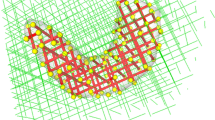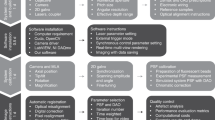Abstract
The quantitative investigation of images taken from light microscopy observation is one of the pillars of biological and biomedical investigation. The main objective is the count of objects, usually cells. In addition, the measurement of several morphological parameters, such as the diameter of cells, the length of vessels, etc., can also be important for the quantitative assessment of the features of a tissue. Whereas counting and measuring histological elements may appear easy, especially today with the availability of dedicated software, in fact it is not, since what we can count and measure on light microscopy images are not the true histological elements but actually profiles of them. Obviously, the number and size of profiles of an object do not correspond to the object number and size and thus significant mistakes can be made in the interpretation of the quantitative data obtained from profiles. To cope with this problem, over the last decades, a number of design-based stereological tools have been developed in order to obtain unbiased and reliable quantitative estimates of cell and tissue elements that originate from light microscopy images. This paper reviews the basic principles of the stereological tools from the first disector applications through some of the most recently devised methods.



Similar content being viewed by others
References
Abercrombie M (1946) Estimation of nuclear population from microtome sections. Anat Rec 94:239–247
Benes FM, Lange N (2001) Two-dimensional versus three-dimensional cell counting: a practical perspective. Trends Neurosci 24:11–17
Cassel CM, Sarndal CE, Wretman JH (1993) Foundations of inference in sampling. Krieger, Malabar
Coggeshall RE (1992) A consideration of neural counting methods. Trends Neurosci 15:9–13
Coggeshall RE, Lekan HA (1996) Methods for determining numbers of cells and synapses: a case for more uniform standards of review. J Comp Neurol 364:6–15
Cruz Orive LM (1976a) Correction of stereological parameters from biased samples on nucleated particle phases. II. Specific surface area. J Microsc 106:19–32
Cruz Orive LM (1976b) Correction of stereological parameters from biased samples on nucleated particle phases. I. Nuclear volume fraction. J Microsc 106:1–18
Dolapchieva S, Eggers R, Kuhnel W (2000) Automatic image analysis of the postnatal growth of axons and myelin sheaths in the tibial and peroneal nerves of the rabbit. Ann Anat 182:133–142
Farel PB (2002) Trust, but verify: the necessity of empirical verification in quantitative neurobiology. Anat Rec 269:157–161
Gardella D, Hatton WJ, Rind HB, Rosen GD, von Bartheld CS (2003) Differential tissue shrinkage and compression in the z-axis: implications for optical disector counting in vibratome, plastic and cryosections. J Neurosci Methods 124:45–59
Gardi JE, Nyengaard JR, Gundersen HJ (2008) The proportionator: unbiased stereological estimation using biased automatic image analysis and non-uniform probability proportional to size sampling. Comput Biol Med 38:313–328
Geuna S (2000) Appreciating the difference between design-based and model-based sampling strategies in quantitative morphology of the nervous system. J Comp Neurol 427:333–339
Geuna S (2005) The revolution of counting “tops”: two decades of the disector principle in morphological research. Microsc Res Tech 66:270–274
Guillery RW (2002) On counting and counting errors. J Comp Neurol 447:1–7
Guillery RV, Herrup K (1997) Quantification without pontification: choosing a method for counting objects in sectioned tissues. J Comp Neurol 386:2–7
Gundersen HJG, Bendtsen TF, Korbo L, Marcussen N, Møller A, Nielsen K, Nyengaard JR, Pakkenberg B, Sørensen FB, Vesterby A, West MJ (1988a) Some new, simple and efficient stereological methods and their use in pathological research. APMIS 96:379–394
Gundersen HJG, Bagger P, Bendtsen TF, Evans SM, Korbo L, Marcussen N, Møller A, Nielsen K, Nyengaard JR, Pakkenberg B, Sørensen FB, Vesterby A, West MJ (1988b) The new stereological tools: disector, fractionator, nucleator and point sampled intercepts and their use in pathological research and diagnosis. APMIS 96:857–881
Gundersen HJG, Jensen EBV, Kieu K, Nielsen J (1999) The efficiency of systematic sampling in stereology, reconsidered. J Microsc 193:199–211
Hansen LV, Nyengaard JR, Andersen JB, Jensen EB (2011) The semi-automatic nucleator. J Microsc 242:206–215
Hatton WJ, von Bartheld CS (1999) Analysis of cell death in the trochlear nucleus of the chick embryo: calibration of the optical disector counting method reveals systematic bias. J Comp Neurol 409:169–186
Hedreen JC (1998) What was wrong with the Abercrombie method and empirical cell counting methods? A review. Anat Rec 250:373–380
Herculano-Houzel S, von Bartheld CS, Miller DJ, Kaas J (2015) How to count cells: the advantages and disadvantages 1 of the isotropic fractionator compared with stereology. Cell Tissue Res. doi:10.1007/s00441-015-2127-6
Hyman BT, Gomez-Isla T (1994) Alzheimer’s disease is a laminar, regional, and neural system specific disease, not a global brain disease. Neurobiol Aging 15:353–354
Hyman BT, Gomez-Isla T, Irizarry MC (1998) Stereology: a practical primer for neuropathology. J Neuropathol Exp Neurol 57:305–310
Jensen EBV (2000) On the variance of local stereological volume estimators. Image Anal Stereol 19:15–18
Johnson IP (2001) Rapid estimates of neuron number in the confocal microscope combined with in situ hybridisation and immunocytochemistry. Brain Res Brain Res Protoc 8:113–125
Kaplan S, Geuna S, Ronchi G, Ulkay MB, von Bartheld CS (2010) Calibration of the stereological estimation of the number of myelinated axons in the rat sciatic nerve: a multicenter study. J Neurosci Methods 187:90–99
Kristiansen SL, Nyengaard JR (2012) Digital stereology in neuropathology. APMIS 120:327–340
Kubínová L Janáček J (2015) Confocal stereology - efficient tool for measurement of microscopic Structures. Cell Tissue Res. doi:10.1007/s00441-015-2138-3
Kubinova L, Janacek J (2001) Confocal microscopy and stereology: estimating volume, number, surface area and length by virtual test probes applied to three-dimensional images. Microsc Res Tech 53:425–435
Mura A, Murphy CA, Feldon J, Jongen-Relo AL (2004) The use of stereological counting methods to assess immediate early gene immunoreactivity. Brain Res 1009:120–128
Popken GJ, Farel PB (1996) Reliability and validity of the physical disector method for estimation neuron number. J Neurobiol 31:166–174
Popken GJ, Farel PB (1997) Sensory neuron number in neonatal and adult rats estimated by means of stereologic and profile-based methods. J Comp Neurol 386:8–15
Pover CN, Coggeshall RE (1991) Verification of the disector method for counting neurons, with comments on the empirical method. Anat Rec 231:573–578
Rasmusson A, Hahn U, Larsen JO, Gundersen HJ, Jensen EB, Nyengaard JR (2013) The spatial rotator. J Microsc 250:88–100
Saper CB (1999) Unbiased stereology: three-dimensional measurement in microscopy. Trends Neurosci 22:94–95
Schmitz C, Hof PR (2000) Recommendations for straightforward and rigorous methods of counting neurons based on a computer simulation approach. J Chem Neuroanat 20:93–114
Schmitz C, Hof PR (2005) Design-based stereology in neuroscience. Neuroscience 130:813–831
Schmitz C, Eastwood BS, Tappan SJ, Glaser JR, Peterson DA, Hof PR (2014) Current automated 3D cell detection methods are not a suitable replacement for manual stereologic cell counting. Front Neuroanat 8:27
Smith TMF (1994) Sample surveys 1975–1990: an age of reconciliation? Int Stat Rev 62:5–34
Sterio DC (1984) The unbiased estimation of number and size of arbitrary particles using the disector. J Microsc 134:127–136
Tandrup T, Gundersen HJ, Jensen EB (1997) The optical rotator. J Microsc 186:108–120
von Bartheld CS (2002) Counting particles in tissue sections: choices of methods and importance of calibration to minimize bias. Histol Histopathol 17:639–648
Walløe S, Pakkenberg B, Fabricius K (2014) Stereological estimation of total cell numbers in the human cerebral and cerebellar cortex. Front Hum Neurosci 8:508
West MJ (1993) New stereological methods for counting neurons. Neurobiol Aging 14:275–286
West MJ (1999) Stereological methods for estimating the total number of neurons and synapses: issues of precision and bias. Trends Neurosci 22:51–61
West MJ, Slomanka L (2001) 2-D versus 3-D cell counting: a debate. What is an optical disector? Trends Neurosci 24:374
Williams RW, Rakic P (1988) Three-dimensional counting: an accurate and direct method to estimate numbers of cells in sectioned material. J Comp Neurol 278:344–252
Acknowledgment
This work has been supported by the European Community’s Seventh Framework Programme (FP7-HEALTH-2011) under grant agreement no. 278612 (BIOHYBRID).
Author information
Authors and Affiliations
Corresponding author
Rights and permissions
About this article
Cite this article
Geuna, S., Herrera-Rincon, C. Update on stereology for light microscopy. Cell Tissue Res 360, 5–12 (2015). https://doi.org/10.1007/s00441-015-2143-6
Received:
Accepted:
Published:
Issue Date:
DOI: https://doi.org/10.1007/s00441-015-2143-6




